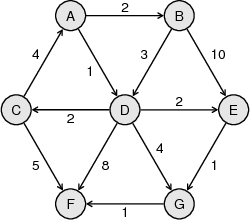CS367 Homework 8
Summer 2016
Due by 11:59 pm on Wednesday, August 3
Announcements
Check here periodically.
| 7/28/2016 | Homework assigned. To ask questions about the homework and see questions posed by other students and their answers, go to: https://piazza.com/wisc/summer2016/cs367 and sign-in using your wisc.edu account. |
Questions
Question 1:
- The ten
most
common words in English, along with their hash codes according
to Java's String.hashCode method, are:
Order Word Hash Code 1 the 114801 2 of 3543 3 to 3707 4 and 96727 5 a 97 6 in 3365 7 is 3370 8 it 3371 9 you 119839 10 that 3558823 Part A: Suppose these strings are inserted into a 14-bucket hash table in the order shown above. Each string's bucket is its hash code modulo 14. If collisions occur, each bucket is implemented as a singly-linked list, with new items added to the head of the list. Show the contents of all buckets after these strings are inserted. Give each bucket as a bucket number followed by a list of strings, with the head of the list at the left.
Part B: Suppose these strings are inserted into a 14-bucket hash table in the order shown. Each string's initial bucket is its hash code modulo 14. If collisions occur, use linear probing with a step size (or offset) of 1. Show the contents of all buckets after these strings are inserted. Give each bucket as a bucket number followed by the string in that bucket, if any.
Given the following graph with nodes having character labels and edges having non-negative integer weights:

Trace Dijkstra's algorithm, starting at node A, by filling in the remaining rows in the table below. Each row in the table represents one iteration of the of the algorithm, so use as many or as few rows as needed for the algorithm to complete. If the priority queue ever contains more than one node with the same distance, break ties using alphabetical ordering of these nodes? names.
visited nodes and their
shortest distances from startpriority queue's items
(listed in increasing order)- (0,A) A:0 (1,D), (2,B) A:0, D:1 (2,B), (3,C), (3,E), (5,G), (9,F)
Question 2:
Handing in
Please include your name at the top your file.
Put your answers to the questions into one file named Homework8 with the appropriate file extension, e.g., Homework8.pdf (see File Format for acceptable file formats).
Electronically submit your work to the Homework 8 Dropbox on Learn@UW.